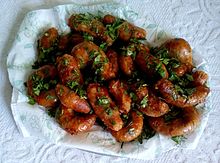This article needs additional citations for
verification. (December 2017) |
 Mombar | |
| Alternative names | Fawaregh, qubawat, merguez, |
|---|---|
| Type | Sausage |
| Course | Main course |
| Region or state | Egypt, Libya, and Levant, and Iraq |
| Associated cuisine | Egyptian cuisine |
| Serving temperature | Hot |
| Main ingredients | Sheep intestines, minced meat, rice |
| Ingredients generally used | onions, spices, tomato sauce |
| Similar dishes | Kofta, Kersha, Kaware |

Mombar (in ِ Egyptian Arabic: ممبار) . (in ِ Arabic: فوارغ) is a kind of Arab sausage dish especially popular in Egypt. [1] [2] Syria, [3] Algeria, Tunisia, [4] and Libya. [5] It is made from sheep casing stuffed with a rice and meat mixture and deep fried.
Ingredients
The main ingredients in mombar are beef sausage meat, rice, tomatoes, onion, garlic, coriander, oil, and spices. [6]
Naming
The equivalent of Egyptian mombar in Syria is qubawat; and palsin in Lebanon and Palestine is known as fawaregh, also known in Libya as usban.
Meat sausages (typically without rice) in North African cuisine are merguez.
Variants
Several varieties of usban exist, and the herbs and spices used can vary but typically include cayenne pepper, black pepper, turmeric and cinnamon, as well as dried mint, parsley and dill. This is added to spring onion, tomato, vegetable oil and rice. The mixture is stuffed into sheep intestines or commercial sausage casings and then tied off with thread at the ends. The sausages cook in a pot for an hour and are then browned in a frying pan or oven.
See also
References
- ^ "Mombar Mahshy (Stuffed Beef Sausage)". touregypt.net.
- ^ ""الممبار" على الطريقة المصرية". youm7.com. Retrieved 26 September 2013.
- ^ "Stuffed sheep sausages (Fawaregh)". tasteofbeirut.com. 17 December 2011.
- ^ "Merguez (A Tunisian sausage)". cooking.nytimes.com.
- ^ "Libyan Food: Cuisine and Recipes". libya-watanona.com. Archived from the original on 4 March 2016. Retrieved 23 November 2017.
- ^ "Spices of the Egyptian cuisine". nilevalley.nl. Archived from the original on 16 July 2017. Retrieved 7 December 2009.